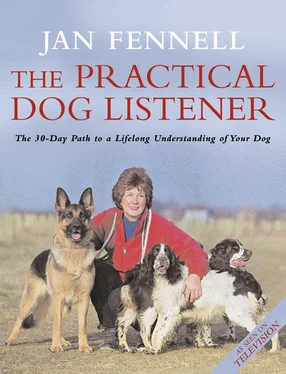I myself was reminded of the importance of mental preparation in the aftermath of the loss of Sasha and Barmie. Their deaths – and the explosive reaction it sparked within my own pack – left me reeling for days. Throughout that time, I knew that I would have to reintroduce all the elements of my method, that I would have to re-establish myself as the unchallenged leader of the pack. The reality was that I was nowhere near ready to do so at that time. My mind was filled with memories of dogs that I had loved and lost over the years. I was in a dream, or nightmare, for most of the next few days. I was angry, hurt and lost.
I was experienced enough by then to know that there was no point in my trying to reapply my method while I was in that state of mind. For the first few days after the fight took place, I simply kept the different factions within my pack separate at all times. I knew how unconvincing I was as a leader. I was being consumed by my human side, there was no place for thinking in the canine terms I needed: it simply would have failed. And I was not going to set myself up for a failure. No one reading this book should take the next step on this journey without being sure they too are willing, able and mentally ready to do so.
PART TWO THE FIRST 48 HOURS
New Horizons: Settling a New Dog in Its Environment
The road ahead is a long, sometimes difficult, but hopefully richly rewarding one. And for some owners, the first potential wrong turn looms within the first moments of bringing a dog home. Dogs that are already acclimatised and settled into a home will be able to begin the first phase of my method – reuniting after separation – immediately. For dogs that are new arrivals, whether they be puppies, adults or rescue dogs, there is a preliminary hurdle to be overcome. It is vital if the new relationship is to get off to the correct start.
Most of us can vividly recall moments like our first day at school, or our arrival at our first workplace. It is an extremely stressful, daunting and, at times, downright terrifying experience. People are operating according to a set of rules we don’t yet understand. The place is filled with unfamiliar sights, sounds and smells. Imagine someone having to fit into a new environment like this when nobody understands what they are saying. This is the situation a dog faces when it takes its first tentative steps into a new home.
Arriving in a new environment is a traumatic experience for a dog. The most important thing you can do during the first forty-eight hours or so is to make this as trauma-free as possible. And it is imperative that the first minutes of the day are spent allowing the dog to settle into its new environment.
The first thing I recommend you do with a new dog or puppy is that, on arrival at the new home, you immediately take it outside to do its toiletting. When the dog relieves itself as you have asked it to, you should reward it with a tidbit. This should be accompanied with warm words of encouragement, such as ‘Good dog’, or ‘Clean dog’, and perhaps a stroke of the head or nape of the neck area. The key point here is that the first piece of positive association has been achieved within the first few moments in the home. A good start has been made.
The next stage is to allow the dog to get to know its new environment. You should leave it alone and let it explore the areas it is free to roam in. Throughout this time, you should be giving out gently affectionate signs, by which I mean smiles and words of reassurance and kindness. At the same time, you should not be gushing or overaffectionate with the dog. This is particularly important in the case of rescue dogs. These are dogs that have had appalling experiences in the outside world. For understandable reasons, their trust may be much harder to win. The key thing here is to remain kind and calm but to keep a respectful distance too. It may well be that the dog is too nervous to engage in any way during the first few hours, or even days. Do not rush the dog: give it space and time.
Settling a dog down into a new environment may sound straightforward. It is not, I can assure you. As an illustration of the hard work that is sometimes required here, I often draw on the example of Murphy. All dogs need to check out their new home, to sniff out the landscape, if you like. Murphy was more qualified than most for this job. He was a police ‘sniffer’ dog. At work, his role was to locate drugs, explosives and contraband.
I met him while visiting his handler, Teresa, a PC with the West Midlands Police. She had expressed an interest in learning more about my method and I had visited her at her home. Murphy, I discovered, lived in a kennel at the rear of the house. When I wondered why he didn’t live in the house she simply laughed: ‘He’d destroy the place,’ she said. By this, she meant that Murphy was simply too inquisitive. His training had encouraged him to stick his nose in anywhere and into anything suspicious. On the rare occasions he had been allowed in people’s homes, this had led to disaster. He would knock things over and generally leave a trail of destruction behind him. In short, he had no house manners.
I offered to illustrate my work by introducing Murphy to the house. He immediately went berserk, leaping around everywhere. I immediately asked for his lead. While Teresa and I sat down and talked, we studiously ignored Murphy’s high-octane behaviour. Throughout, he remained attached to his lead, which Teresa clung to from her chair. After ten minutes or so, he settled down. At this point, Teresa released him from his lead. The reprieve was short-lived: the moment he began leaping around again, I got Teresa to put him back on his lead. She didn’t scold him or shout at him. She simply remained aloof and acted quickly. This process was repeated four times in all.
The next time Murphy was let off the lead, he simply sniffed around our legs. It was as if he was making his final check of the environment. Soon after that, he lay nicely down at Teresa’s side. It was the final symbolic gesture, the signal that he was now ready to begin living, and learning, there.
It is no surprise that many people have problems integrating new dogs into a home that already has one or more dogs living there. My method will ensure that the human members are elevated to the senior positions within the extended pack, but it is important that you acknowledge the canine pecking order below this. This hierarchy is the most natural thing in the world, and nothing is going to change that.
In many, many cases dogs settle into a natural order with very little trouble indeed. But, make no mistake about it, the process can be hugely competitive and can result in aggressive and potentially violent behaviour. For this reason, I must emphasise how essential it is that the initial, introductory meeting between dogs happens on neutral territory. In an ideal world, I would recommend more than one meeting.
If, for whatever reason, your existing pack is only going to meet the new dog on the day of its arrival, this introduction must be your first task of the day. You must choose a neutral ground, and here you must be careful to avoid places where the existing pack has strong associations. In the past, I have taken new additions to my pack to parks or open spaces, areas where they and my existing dogs have been free to weigh each other up and begin the process of integration in a less charged atmosphere. It requires the assistance of someone else to lead either the existing pack or the newcomer to the spot. Even if this only lasts for half an hour before the new dog arrives home, it can be of huge long-term benefit.
If there is more than one dog in the existing pack, I suggest you introduce these dogs to the newcomer one at a time. Each time this happens, it is vital the two dogs meet on equal status. As the newcomer is going to be on a lead, the existing pack member should also be on a lead. If one dog is being rewarded with toys or treats, then so should the other. The vital thing here is that the two dogs form a new, extended pack. By exuding strong leadership, you should be implanting the idea that the job of Alpha within this pack is already taken. The newcomer will obviously be less well versed in your communication methods than the established dog. Yet the message should begin to seep through just the same: by all means sort out a pecking order amongst yourselves, but be certain that the job of leader is not up for grabs – nor will it ever be.
Читать дальше












